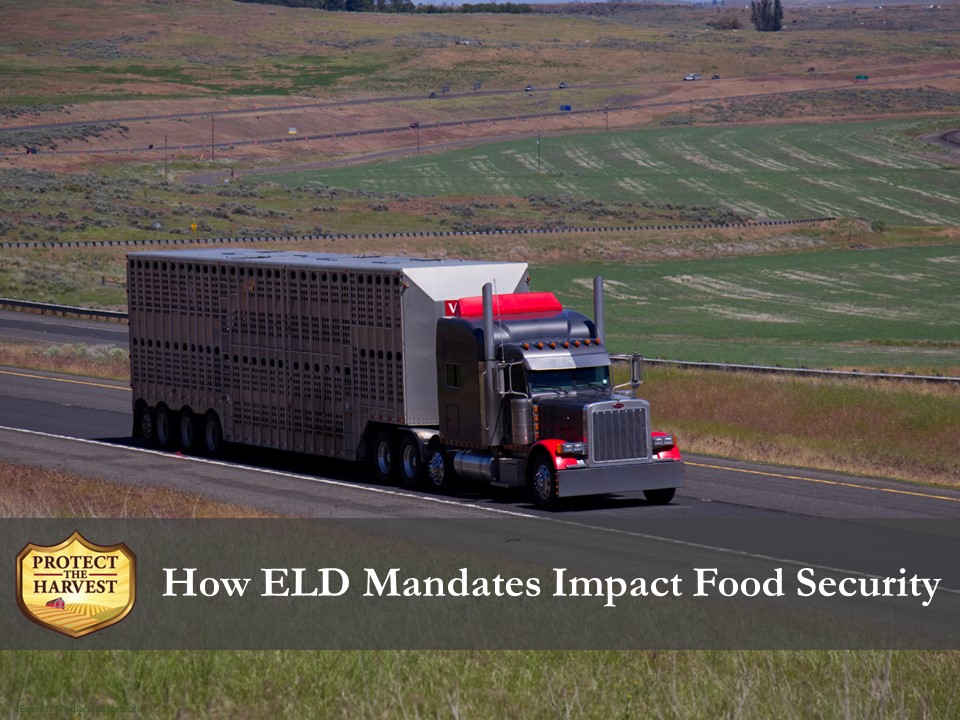By Jaclyn Krymowski for Protect The Harvest
Americans are blessed with an abundant, safe, and relatively inexpensive supply of food. We rarely consider how food gets to the grocer, except when shelves are bare and supply chain issues are in the headlines. When we do consider food security and agriculture, we may think about issues that impact farmers or, in some cases, our grocery store. However, we don’t often think about the regulations, legislation, and restrictions that impact the activities which bring the food from the farm to the grocery store. When it comes to what’s on our plates, most people are not thinking about logistics and transportation.
Transportation and Food Security
Our food supply chain relies heavily on highway transportation to get products and livestock from farm to processor to packer to wholesale and finally to the retail level. More than 70% of all food is transported via truck in the U.S. and much of it travels extensive miles. This is due to the nature of our food system. To bring high-quality food produce and proteins to consumers year-round requires movement from different regions. For example, it is not possible to grow strawberries year-round in the Midwest like it is in Florida and California. Likewise, coastal areas aren’t in close proximity to finishing yards and meat packers which are primarily located in central states. The segmented journey of food from farm to table is all thanks to truckers who can move in an efficient and timely manner to keep food fresh and safe.
Regulations and limitations on truck drivers impact how quickly products can move from one location to the next. Products usually travel great distances to reach consumers, crossing state lines and, often, moving from coast to coast. Beyond timeliness is the issue of perishability. Many food products are highly perishable and cannot be on the road for long periods of time.
If our food cannot get where it needs to go, food security for our nation is at risk.
Regulations Impact Trucking and Logistics
Right now, a big transportation challenge comes from a sharp increase in regulations that impact truckers and are implemented and enforced through the use of electronic logging device (ELD) mandates. The ELD mandate requires commercial vehicles to be equipped with an electronic device that logs and tracks travel data. This allows for the formal enforcement of strict limitations on drive time and rest periods. This scrutiny is causing drivers additional time and complications when planning on moving their loads. Heavy traffic found in most metro areas and fuel stops further complicate the logistics.
While most commercial driving regulations are state level, the root of the ELD mandate and related issues stem from a bill signed by President Obama in 2012: “Moving Ahead for Progress in the 21st Century.” The bill required the Federal Motor Carrier Safety Act (FMCSA) to develop a formal rule to mandate the usage of ELDs on all commercial vehicles.
In theory, the ELD provides a structure that prevents drivers from becoming fatigued during long hauls. However, on a logistics level, this is simply cumbersome and impractical for the transportation of perishable food items and livestock. It also causes issues for drivers traveling through metro areas with the goal of avoiding heavy traffic times. Simply put, the mandates do not allow for driver autonomy and in many cases do not allow a driver to sleep when needed and demand a break for sleep when the driver is rested and ready to drive. Though the fact that ELD mandates do not work is abundantly obvious for the livestock and food industries, much of the mandate issues remain unresolved despite efforts to coordinate resolutions with lawmakers.
Animal Welfare Concerns
Initially, ELD mandates came with exceptions for food and fuel, livestock feed, and COVID relief supplies during the height of the pandemic. In May 2022, this changed. As the country resumes some degree of “normalcy,” many mandates are being reinstated. This poses very real concerns about food security, both in terms of moving food fast enough to meet demands and moving it in a safe manner that avoids damage and mitigates welfare concerns for livestock.
Transporting livestock properly requires careful attention to animal welfare. Excessive time on the road, especially when a trailer is stopped, poses some serious welfare concerns.
Other Issues
The mandates are creating a perfect storm of challenges. Not only is it more cumbersome to fulfill orders due to a shortened work window, but it has also contributed to an already problematic shortage of drivers. More strain on the transportation sector from regulations and difficulty in fulfilling shipments ultimately feed into inflation.
With the latest mandates, ELDs need to be current (less than five years old) and their records cannot be tampered with. As well, most companies prefer a wireless transmission of the reports logged by the ELD. This alone is significant because some older vehicles don’t have the capabilities to provide the needed data to an ELD. In fact, when the regulations were first initiated, there was wording made specifically for these vehicles.
Railways also play a large role in the commodity sector, including grains and oilseeds. If a railroad strike causes a shut down, farmers are left stranded and searching for alternatives for storing and preventing spoilage. In addition, if grain processors shut down, farmers would be left with large quantities of crops.
The impact would also expand into our grain exports, as a third of our grain exports travel by railway, and limit America’s ability to ship food to foreign nations.
With the added strains on the trucking segment, it is unlikely that moving grain on the highway to offset such a deficit will be feasible anytime soon.
The Impact on Independent California Operators
California is especially punitive, cracking down on ELDs and similar driving regulations. This hits the state’s numerous small-scale, independently-owned drivers very hard. On a national level, our trucking capacity is greatly reliant on independent owner-operators as they account for a large share. There are over 70,000 independent drivers in California alone which assist in hauling goods from the state’s largest ports.
California truck drivers face even more pressure than the rest of the country’s drivers. The state made the decision to outlaw trucks equipped with pre-2010 engines. Enacted with the intent to reduce exhaust emissions, this took effect in January 2020. To enforce this, the state’s department of motor vehicles is denying all registrations to vehicles falling within this category. It is on track to ensure nearly all trucks and buses, commercial or otherwise, are compliant with 2010 or newer engines by 2023.
Many independent owner-operator drivers are concerned the laws will drive them out of business and in many cases, drivers have already quit. With the reduced number of truckers, shipping rates will increase as ports continue to back up. These ports are already overwhelmed by the effects of the pandemic.
COVID, and the governmental oversight that accompanied it, not only put a strain on the overall workforce but the long lead times and delays at port. Many of these impacts are still in effect today for all types of food-related industries. The result is an even heavier workload for the drivers that are available in addition to having even more limits to navigate.
We previously expanded upon how regulations have compounded some situations and continue to impact the supply chain. Not only have the regulations put more stress on drivers to race against the clock but have limited California drivers more specifically.
As noted in a past PTH article:
“These regulations have far-reaching effects throughout the nationwide trucking industry due to the sheer number of loads that originate in California from the state’s seaports and massive agriculture industry.”
The Heavy Toll and Harsh Reality
It will be a continuous process for the agriculture and transportation sectors to work at restructuring these mandates. Unfortunately, it takes time, lobbying, money, and lots of effort to relay to lawmakers and the public why these impacts are so detrimental.
Resolving these issues not only safeguards the livelihoods of many drivers but is also essential to preserving food security for all Americans who rely on the entire supply chain working efficiently to get food on their tables. As lead times continue to increase, especially due to the shortage of drivers, some of these mandates will need to be reevaluated to make sure our food supply chain doesn’t crumble and cause more food deserts in hardest-hit communities.
If a large population of independent drivers is driven out of business, shortages will ensue and prices of common household essentials will skyrocket. As we’ve discussed so many times, high food prices always impact the most vulnerable members of our communities, families who are struggling to get by and need affordable food the most.
Links
Read more about our ELD issue coverage HERE
Read more about issues with older vehicles and ELD compliance HERE
Read our previous coverage of regulations and inflation HERE
Read more about animal welfare concerns and mandates HERE
Inflation related to over-regulation and logistics article HERE
Article by GPS Technologies and ELD HERE
Article in The Hill regarding railroad strike impact HERE
Article in Wall Street Journal regarding trucking in California HERE




